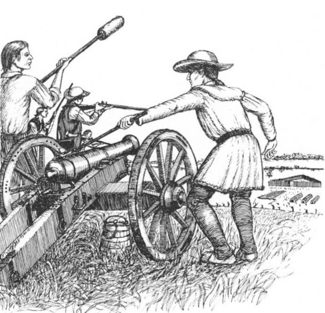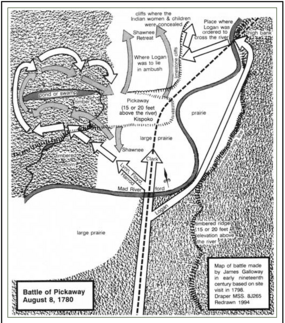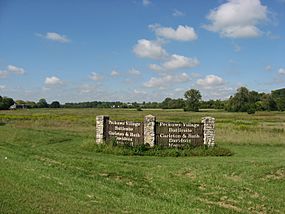Battle of Piqua facts for kids
Quick facts for kids Battle of Piqua |
|||||||
|---|---|---|---|---|---|---|---|
| Part of the American Revolutionary War | |||||||
 |
|||||||
|
|||||||
| Belligerents | |||||||
Shawnee |
Kentucky Militia of Virginia State Forces |
||||||
| Commanders and leaders | |||||||
| Chief Black Hoof | George Rogers Clark | ||||||
| Strength | |||||||
| 450 Shawnee, Delaware, Wyandot and Mingo warriors | 970 militia | ||||||
| Casualties and losses | |||||||
| 6-5 killed 3 wounded |
42 killed + 9 killed/wounded prior to battle +2 DOW after battle 40 wounded |
||||||

The Battle of Piqua was an important fight during the American Revolutionary War. It happened on August 8, 1780, in a Native American village called Piqua. This village was located along the Mad River in what is now western Ohio.
The battle was fought between American soldiers from Kentucky and Shawnee Native Americans. The American forces were led by General George Rogers Clark. The Shawnee warriors were led by Chief Black Hoof. After the battle, the Shawnee were forced to leave their village. The American soldiers then burned the village and the nearby farm fields. Even though the Americans won, they had many soldiers injured or killed.
Why the Battle Happened
The Battle of Piqua was part of a larger conflict in the Western theater of the American Revolutionary War. Earlier in the summer of 1780, a group of Shawnee, Delaware, and Miami Native Americans, working with the British, had attacked settlements in Kentucky. This attack, known as Bird's invasion of Kentucky, caused many American deaths and captures. General George Rogers Clark led his expedition to get revenge and stop further attacks.
The Campaign Begins
General George Rogers Clark gathered about 970 soldiers for his mission. In early August 1780, they crossed the Ohio River near where the city of Cincinnati is today. From there, they marched north along the Little Miami and Mad Rivers.
Their first stop was the Shawnee village of Old Chillicothe. This village was near what is now Xenia, Ohio. When Clark's soldiers arrived, they found the village empty. Clark ordered his men to burn it down.
The Fight at Piqua
After burning Old Chillicothe, Clark's forces moved a few miles north. They reached the village of Piqua on August 8, 1780. This Piqua village was not the same as the modern town of Piqua, Ohio. At that time, Piqua was the main village for the Shawnee people. It was home to many people and had a small fort built around it.
The battle lasted for several hours. Both sides fought hard and many soldiers were hurt or killed. General Clark used cannons to attack the Shawnee fort from cliffs above the village. This powerful attack forced the Shawnee warriors to leave their village.
After the battle, Clark's soldiers spent two days destroying the area. They burned about 500 acres of corn fields around the village. This was done to make it harder for the Shawnee to live there.
What Happened Next
General Clark reported that 27 of his men were killed or wounded. However, later accounts from people who were there suggest the number was much higher. At least five Shawnee warriors were known to have died.
The Shawnee people were greatly affected by this defeat. Instead of rebuilding Piqua, they moved to a new location. They settled along the Great Miami River, north of today's Piqua, Ohio. They named their new village Peckuwe, which later became "Piqua."
The Battle of Piqua was the largest battle of the Revolutionary War fought west of the Allegheny Mountains. It was one of only a few military battles that took place in the Ohio Country during the war.
Legacy
Today, you can visit the site of the battle. A memorial trail and state park were built there. It is called the George Rogers Clark Memorial. It is also known as Tecumseh State Park.
In 1922, a special ceremony was held at the park. They unveiled an 18-foot marble statue of George Rogers Clark. The park was made larger in 1930. On the 150th anniversary of the battle, a historical meeting was held at Wittenberg College.


